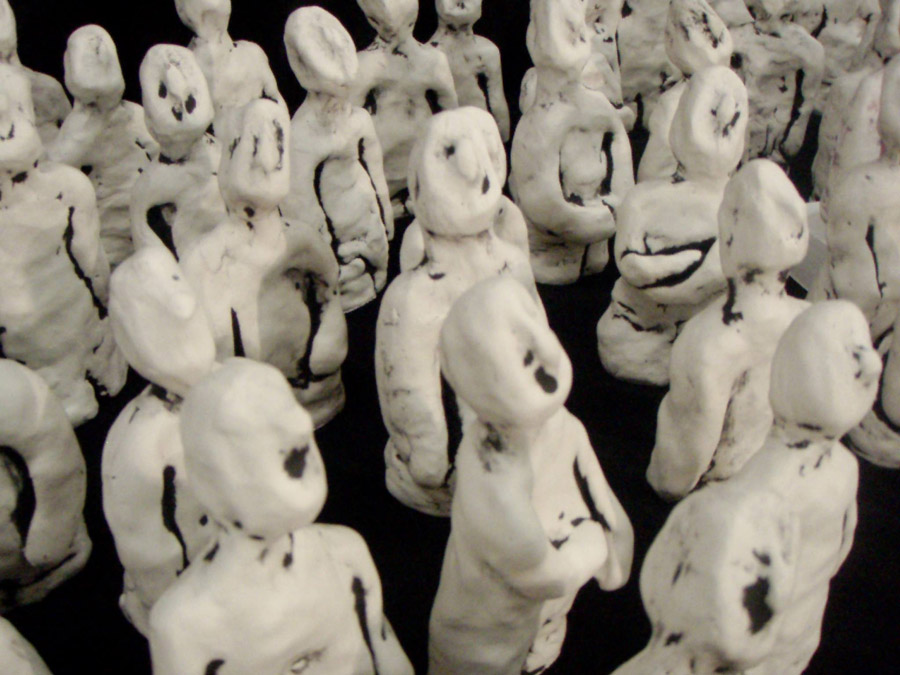
Senior Projects, Fall 2021
December 10 - 17, 2021
Wasmer Art Gallery
Presentation of Artists, 5 - 7pm, Thursday, December 9, 2021
Sponsored by The Layden Family Foundation, The Smith Family Foundation of Estero and WGCU Public Media
Image credit: Krista Robbins, Untitled (detail), 2007, Ceramic installation of 100 figures, each approximately 6 x 2 x 3 in.
-
Anastasia Baran PIGMENTATION OF EMOTION
Toggle More Info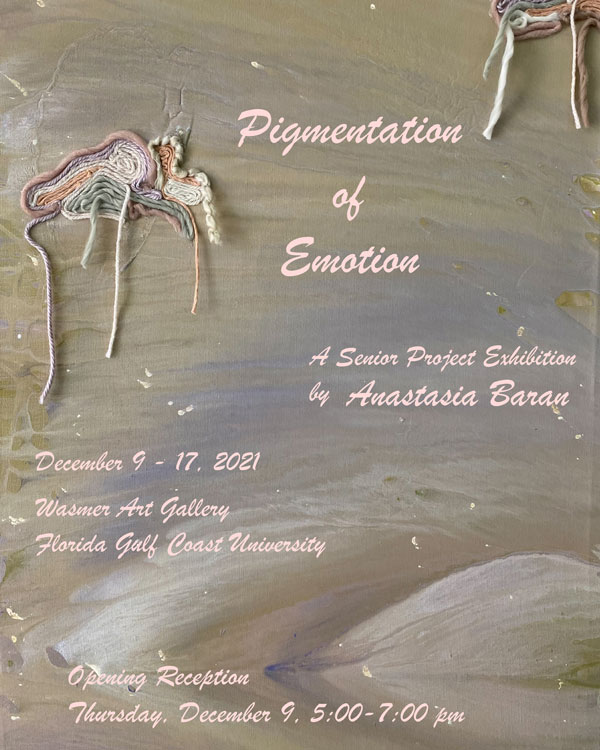
My series, Pigmentation of Emotion, is about color psychology. This is the study of hues relating to and affecting human emotion. In Art Therapy colors are associated with specific emotions. This can be as simple as blue evoking sadness and red evoking anger. The colors used in my artwork work in the same way, calling up specific emotions from the viewer. My degree is in Visual Arts with a minor in Psychology. Combining these two fields has become a paramount passion for my future. After graduation, I will pursue an Art Therapy postgraduate degree. This series of artworks represent my intent to portray various emotions through the use of color, fluid patterns, and textural fibers. My intent is to create a personal emotional reaction from the viewer.
I have created three paintings using color psychology to express three emotional states of being that are inherently different from each other, yet intensely important to me personally. These emotions are peacefulness, passionate, and anxiousness. The way the canvas is fluidly painted reinforces how each emotion feels to me. The paint, when poured, flows in the direction you physically move the canvas, just like the way our feelings move through us. They course through our brain and send messages through our body. The canvas size and proportion were chosen to represent my physical size; my body. The yarn is to represent the nervous system, the veins, and the inside of my thought processes. This series is about my inner emotions portrayed as a physical form of myself.
For this series, I have chosen three emotions. They are peacefulness, passionate, and anxiousness. Peacefulness is a free-flowing design with green, pink, purple, and white hues. Passionate uses deeper colors such as magentas and purples to create a deep flourishing effect. Anxiousness is meant to create an uneasy feeling using yellows, deep blues and reds. Silicone oil added to the paint creates ‘cells’ on the surface. These cells create a static, vibrating feeling that anxiety is to me. Incorporated onto each painting are yarn elements. These fibers represent the nervous system and correspond to emotions. Peacefulness has a fluent, loose design. Passionate has dramatic jagged designs and anxiousness has a nervy intricate design. I have intentionally pulled the same colors from the painting to match with the yarn. For all three paintings I have used the technique of puddle pouring. This technique is where you pour each color after another. This creates a puddle mixture which you can move around to create a desired effect. I decided on this effect due to its fluidity and how I could use the paint to really represent my feelings through moving it. This relates to my emotions as they come and go just like the paint moves on the canvas; in waves.
-
Ximena Candelario CREATIO EX NIHILO CREATION OUT OF NOTHING
Toggle More Info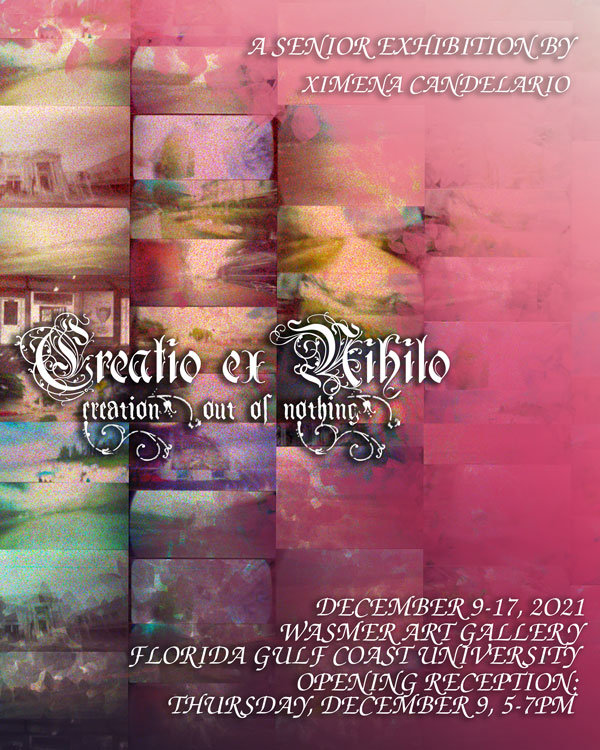
Modern photography is a blend of many different styles and movements. There is no ideal way to create a distinction between these styles anymore so many photographers simply identify their work by what influenced them. My series, Creatio ex Nihilo, is a blend of Lomography, Amateur, Pictorialist, Street, and Experimental photography. This series is also heavily inspired by the work of the French philosopher, Roland Barthes. He created a theory of photographic meaning that revolves around two phrases, Studium and Punctum. Studium is the historical, social or cultural meanings found in photography that are identifiable by the viewer. Punctum is the sensory, subjective effect that a photograph has on the viewer and does not rely on representation. Creating Punctum within a photograph is essential as it allows the viewer to experience their own subjective interpretation of the image. But how can something be created out of nothing?
This project is a way for me to explore photography in a way that I have never done before. For the past eight years, photography has been the only medium to continuously stimulate my creative expression. I find that capturing authentic moments of time has allowed my view of the world to shift. A lone chair on the side of the road or an odd cloud would have never caught my attention years ago, but now I find myself fascinated with these small oddities and already planning how to photograph them. There was a point in my career where I had taken nearly 10,000 photos of random objects on the street that I found pleasing. However, after properly studying photography, I noticed my mindset had shifted and I became focused on creating images that fit the standard rules of photography instead of capturing the world around me. My senior project is an ode to the medium as well as a way for me to break free from the restrictive frame of mind and explore a new theology and technique.
In order to create something out of nothing, I blended various photographic styles as well as used manual manipulations to create my images. For years, I have practiced digital photography, but in order to create images with Punctum it was necessary to switch to analog photography. Analog photography refers to the use of an analog camera, in this case a toy camera, that is loaded with film. For this project, I used the Holga 120N, Holga 120WPC and Diana F+ toy cameras as well as various 120mm Lomography films with different ISOs and color spectrums. The toy cameras added a spontaneous element to the photography as they create various effects that can completely change an image based solely on the lighting, color or shutter speed. Using the cameras and the film, I set out on walks to crowded streets to capture the essence of the areas with little thought to how the image may appear. After shooting the film, I developed it all myself using my knowledge of film and darkroom chemicals. My black & white film was developed using my own mixture of Caffenol-C, while my color film was developed using Unicolor Powder C-41 that I mixed myself. After my film dried, I cut them up into strips of three and scanned them using my Epson v600. Once the film was scanned, I was finally able to see how they came out and then lightly edited them using Camera Raw. Some of the film then was further manipulated using film soups and fire. The finished photos were then printed and arranged on PVC boards in various gradient patterns.
-
Erin Exum Mitákuye Oyás’iŋ (ALL MY RELATIONS)
Toggle More Info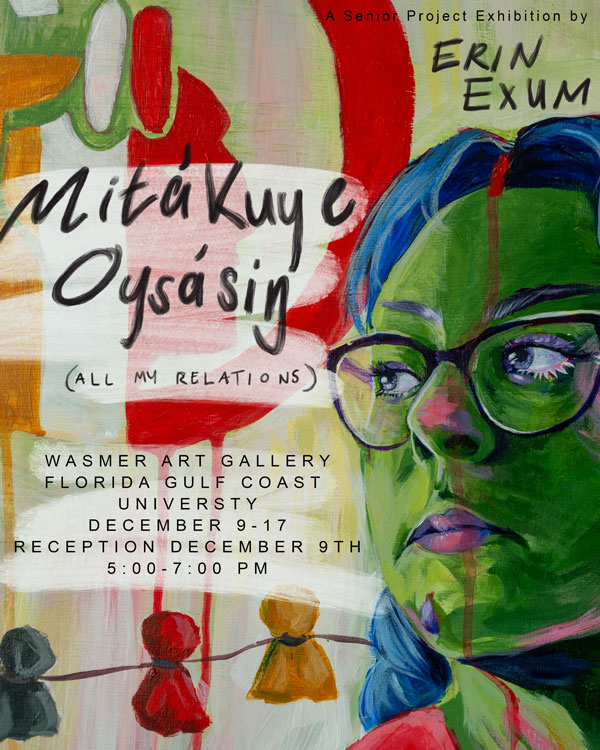
The United States of America have 574 federally recognized Native American tribes with half subjected to life on a federal reservation. These reservations were put in place in the 19th century as a way to contain the “Savage Indian” from the “refined” euro-centric settlements. The living conditions of these reservations are often compared to that of a third world with rampant drug and alcohol abuse as well as domestic violence on women. 85 % of these women will experience violence during their lifetime. Historically these has been habitual since the beginning of federal reservations, creating dysfunctional social situations. Despite these trials Native people continue to thrive and share their vibrant, rich culture. Paving the way for new ideas of what it means to be Native American for a new generation of indigenous youths.
For this exhibition, I wanted to highlight both the good and the rough parts of being a Native American person in this modern era. Growing up in a strange fusion of suburbia and traditional Native values from both sides of my family, it was through the women in my life that I learned some of the most important lessons. This series portrays my female Native heritage beginning with my great-great-great grandmother and ceasing with me. Within each portrait, there are symbols and objects that surround the figures. These are symbols and objects that I grew up around and they hold deep meanings within the Native communities where I was raised in. Where there is beauty there is also the unsightly. These traumas and struggles are represented through an assemblage sculpture. This pile of found/handmade objects represent the sources of where these traumas come from. Most of these traumas affect not only an individual person, but the people around them, ending up causing a long line of generational trauma. The selection of triggering materials were made based on my personal relationship with them; from watching my mother’s battle with diabetes to watching yet another Native person ending up an alcohol abuser statistic. These tools of an ongoing attempt of genocide are not what makes a Native person or community. Native people are not just the stereotypes that many people identify with us. My purpose is to show that these women and other indigenous peoples are still deserving of being shown as a dignified group despite their personal and collective strife. Native people and culture(s) deserve to be shown as they are, alluring and above all perseverant against anything.
This exhibition consists of five paintings and one assemblage sculpture. For the paintings I collected photographs of each woman eventually narrowing down to each specific reference photo. I made sketches of each painting figuring out compositions, color palettes and what symbols I wanted to include in each. Samples were made on multiple different surfaces and reworked to ensure the composition and colors looked good on a painted surface before moving to the larger 24 x 30-inch wooden panels. While it was more expensive, I prefer wood to canvas as it gave a more sophisticated quality. I used a variety of different acrylic paints, ranging from fluid, heavy body, expensive and cheaper paints to achieve my desired look. During this time, I began collecting objects for the sculpture; either bought or donated. I played with arrangement until one gave the most dynamic composition. Some objects were aged and weathered to give a grimy and used look, others were left either clean or completely clean to show the cycle of never-ending abuse/trauma. After collection of store-bought objects, I made the rest to fill in the gaps and assembled it on site.
-
Katja Redes LOOKING GLASS
Toggle More Info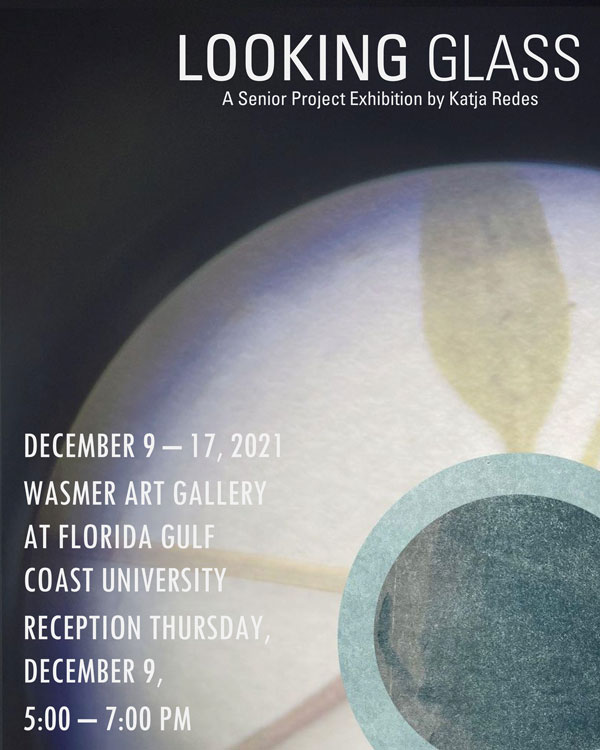
“The identity of the woman disappears, only a fetish object remains, which is the focus of men's desires.”
-Birgit JurgesnnsonHumans have been depicted throughout Western art history primarily in their ideal forms, rather than how they actually appear. Women were often shown in ways that were acceptable for their society at the time. Fast forward to today, women are being watched for every minute detail. Media has evolved into different formats from painting to magazine to social media to scrutinize women’s bodies. In addition, we have also been monitored in both public and private spheres. Men often sexualized women’s own existence when we are doing the same things that they do. This combination has worked together in a way to make women watch their every move and change the way they act as a result of being constantly under surveillance.
I examine the psychological toll sexualization has on women that are just simply trying to live their everyday lives. Rather than exploring specific instances of young girls and women being objectified, I wanted the viewer to feel uncomfortable as they call to mind their own life and how they felt in similar situations. My artworks relay my own personal experiences of unwanted male attention. I also feel these are commonly relatable to most people. My intention is to focus on the times women have been objectified for existing and to also bring about the concept that this critical gaze affects both our actions and the way we see ourselves. People react differently when feeling like they are being watched, so by being continuously overseen it affects the psyche even more. My pieces include eye imagery to make the viewers feel as if they are being watched in separate situations. In one of my paintings, I demonstrated this concept by portraying a dressing room as it is a private space that has been used for recording women. The pieces follow a similar color palette, highlighting the color green as it is commonly used to create a sense of unease.
Making the work began with observing how to create the right kind of molds for eyeballs and ice cream cones. After trying to roll out balls of polymer clay by hand, I found that it was easier to use measuring spoons as molds to create half-spheres. Once I created an indent on the surface of the eyes, they were baked in the oven to be painted with acrylics once cooled. To make the eyes even more believable, they get covered in epoxy resin to make them glossy and reflective. For the ice cream cones, I was able to recreate the texture of a waffle cone by rolling out slabs of polymer clay onto a raised surface. Through research, I discovered that silicone looked the most similar to the dessert in a soft serve ice cream. As for the paintings, I came up with a couple designs and chose two images with color schemes that connected with the sculptures. Rather than painting on blocks of color, I decided to paint in layers of various colors.
-
Gabi Rost TRICHY
Toggle More Info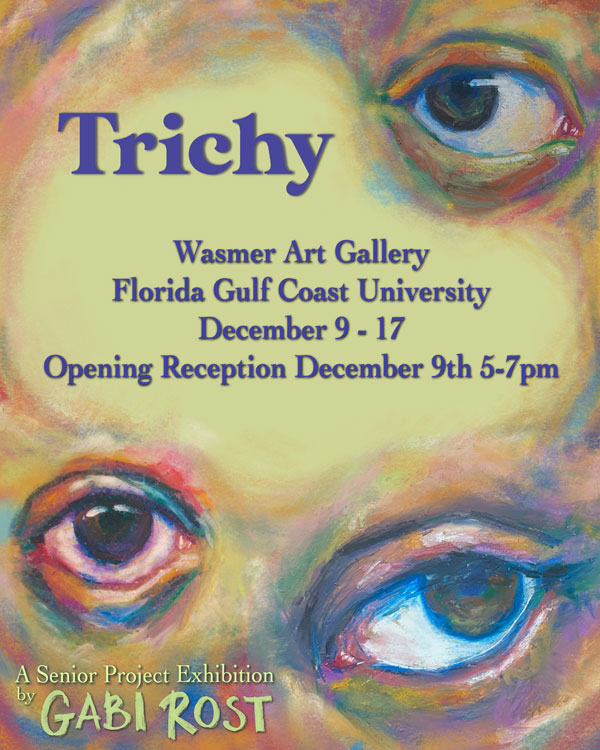
Trichotillomania, or Trich for short, is a mental disorder that causes a person to compulsively pull out their hair. Most people with the disorder pluck the hairs from their head, while others pull out their eyelashes and eyebrows, and various body hair. Trich is categorized as a body-focused repetitive behavior (BFRB), which encompasses disorders like skin-picking, nail biting, and nose picking. These disorders are independent diagnoses; however, they frequently occur in conjunction with anxiety disorders, as well as depression, OCD, and ADHD. People affected by Trichotillomania and other BFRBs sometimes hide their disorder from others, as they can be seen a “bad habit” rather than a mental illness. The early teenage years of 10 to 13 are when most of the affected people develop symptoms. Having this illness at such a developmental stage of life can have harmful effects, both physical and emotional. Physically, a person’s appearance can be altered by bald spots or hair loss, as well as unsightly red and swollen areas. Emotionally, this can be detrimental. When combined with other mental illnesses it can cause self-image issues and isolation.
Trichotillomania has been a lifelong struggle for me, as I’ve had the disorder for nearly 15 of my 22 years. As previously stated, most people with Trichotillomania pull out the hairs on their head, but for the most part I pull out my eyelashes and eyebrows. This has caused me to develop an obsession with eyes, as my experience with this disorder is centered around my eyes. Not only am I acutely aware of my own, but I am also constantly aware of the eyes of other people looking at me. As a child, I went in public barefaced, with no eyelashes or eyebrows, and I have received glances in passing as well as outright stare downs, due to my appearance. This led me to develop body dysmorphia and other extreme self-image and self-esteem issues, which has caused depression and anxiety. To me, this project is a way to show people what happens in my mind, what I see throughout my daily life that leads me to pull out my own hair. My goal with this body of work is to shed light on what life is like for people with this disorder. For the title, I have chosen Trichy, which is a play on words of “Tricky”. When something is described as tricky, it is meant that the particular problem or situation is difficult to deal with, which is how I often feel about my experience with Trichotillomania.
This series of works includes representational oil pastel drawings of my own eyes from various angles, as well as different degrees of closeness. Some images show both eyes and others will show a close up of one. Along with the eye studies there are images of hands and fingers to show the act of pulling the hairs, as well as drawings of what hair follicles look like under a microscope. These will range from 4 x 6 inches to 5 x 10 inches, depending on content and the space needed per image. As for my process, I started by drawing multiple eyes, exploring various art styles and color palettes before settling on my current choice. I have decided on a modern Expressionist style for the eyes with vibrant colors and unrealistic skin tones, as opposed to a photorealistic design. The drawings of hands will be in the same style as the eyes, and drawings of hair follicles will add contrast since they will be drawn in various shades of grey, black, and white. The drawings themselves will be arranged on the wall in a somewhat symmetrical circular pattern in rows, all the images intermixed with each other.
-
Angela Speak COLONY COLLAPSE
Toggle More Info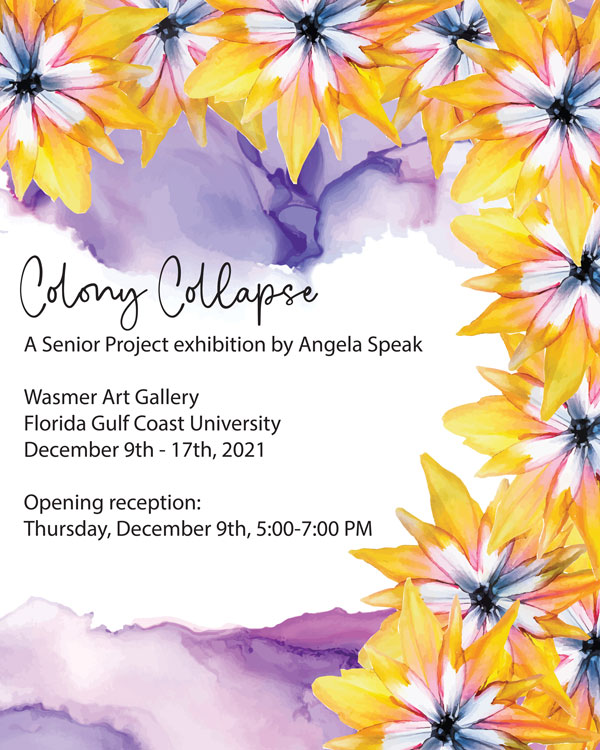
“The bee collects honey from flowers in such a way as to do the least damage or destruction to them, and he leaves them whole, undamaged, and fresh, just as he found them.”
– Saint Francis de Sales
Imagine a world without tomatoes, beans, carrots, and countless other fruits and vegetables. This is what the world would be like when the last bee takes flight for the very last time. Pollination is needed for plants to reproduce, and so many plants depend on bees as pollinators. Successful pollination allows plants to produce seeds. Pollinators transfer pollen and seeds from one flower to another fertilizing the plant so it can grow and produce food. Without bees to spread seeds, many plants including food crops, would die off. Humans rely on the bees to pollinate our food crops so we can eat, yet we are responsible for the declination of the bee population. Humans have been impacting these pollinators for a very long time by using pesticides and herbicides, as well as, transforming landscapes from flowering meadows and fields into cities and neighborhoods.
Growing up on ten acres that was mostly wooded I was always saving some type of animal from its despair. As a young child I would sneak into my room baby birds and turtles that I thought needed my help. Once I thought they were ready to go back into their natural habitat I would release them. Fast forward to being a student at FGCU and being required to take courses on sustainability and permaculture, I learned the importance of the impact that bees have on our world. I have incorporated bee awareness into many art classes that I have taken; therefore, it was only fitting for me to do my last project on bees. My goal is for my viewers to gain the same respect for bees that I have so we can make a positive impact and stop the declination. My intention for my senior project is to invoke people to think about how they affect the bees and to make a change that can have a positive impact on these pollinators.
My process for this exhibition began with researching bees and the impacts that humans are having on them and their environment. I began to think about our impact on the flowers and trees that the bees pollinate and how we are poisoning the bees through these plants. I chose to use 9” X 11” and 12” x 12” porcelain tiles for my canvas because it is made from raw materials from the ground. This is significant because the ground is where all the pesticides and herbicides get soaked into. On the tiles I use the flow and fluidity of the alcohol inks to make abstract flowers. I chose colors that would resemble the different flowers bees are attracted to. I then chose to use black alcohol ink to go over a portion of the flowers to show the decay we are causing as humans. To balance out the negative impact I will be creating a series of three watercolor paintings that will show the bees and some of the flowers that they pollinate.
